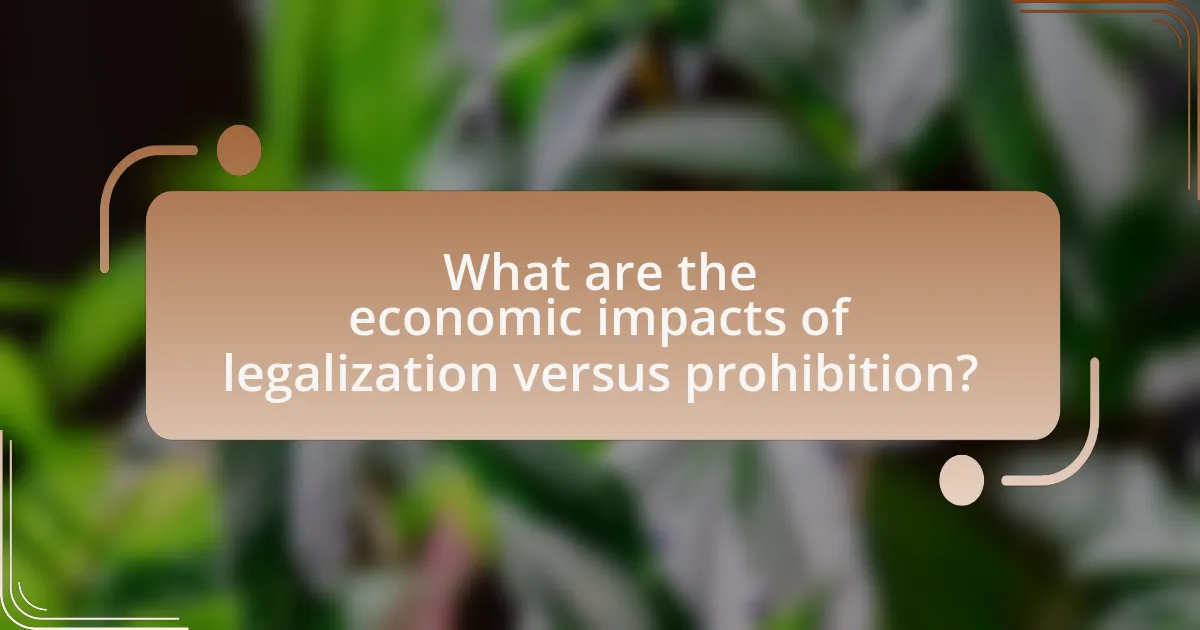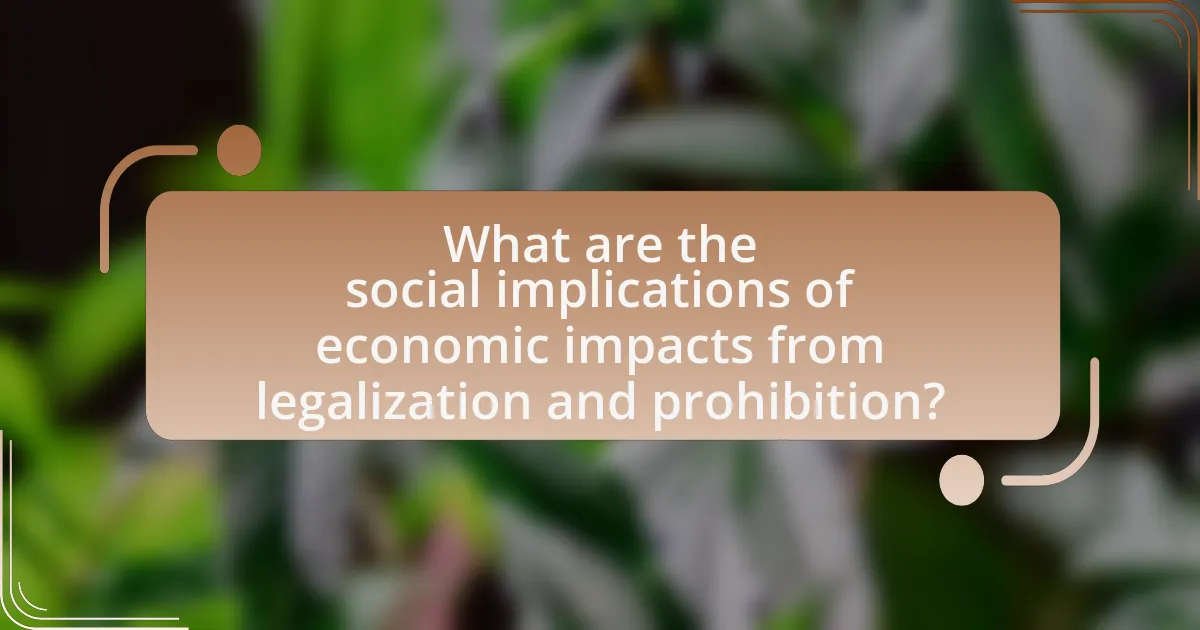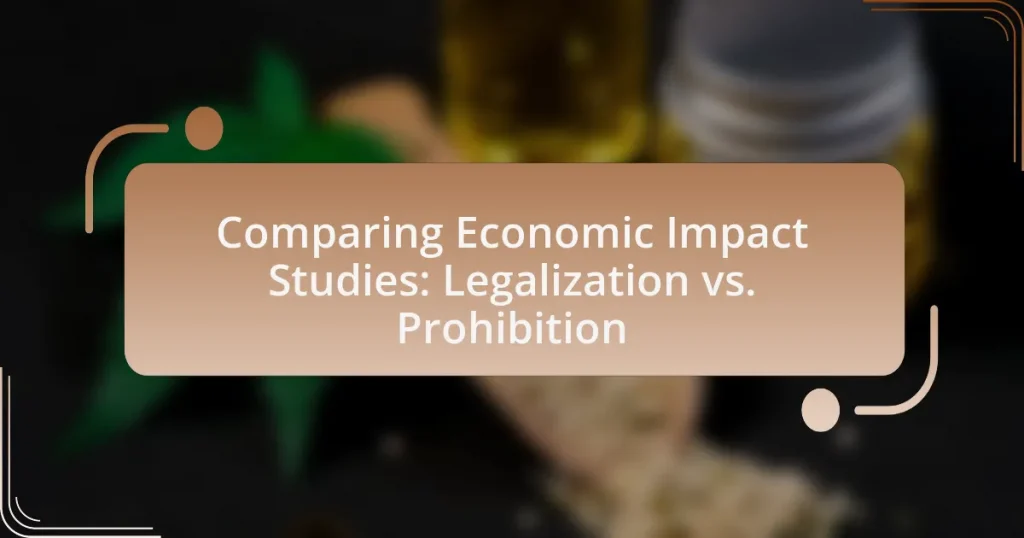The article examines the economic impacts of legalization versus prohibition, focusing on key areas such as government revenue, employment, consumer behavior, and public health. It highlights that legalization typically results in increased tax revenue and job creation, as evidenced by states like Colorado, which generated significant cannabis tax income. In contrast, prohibition often leads to higher law enforcement costs and a thriving black market, negatively affecting economic opportunities. The article also discusses the social implications of these economic outcomes, including crime rates and public health, while analyzing comparative studies and methodologies used in assessing these impacts.

What are the economic impacts of legalization versus prohibition?
Legalization generally leads to increased tax revenue and reduced law enforcement costs, while prohibition often results in lost economic opportunities and increased criminal justice expenditures. For instance, states that have legalized cannabis have reported tax revenues exceeding $1 billion annually, as seen in Colorado, where cannabis tax revenue reached $387 million in 2020 alone. Conversely, prohibition can lead to significant costs associated with policing and incarceration; the U.S. spends approximately $47 billion annually on drug enforcement. These economic impacts highlight the financial benefits of legalization compared to the costs associated with maintaining prohibition.
How do legalization and prohibition affect government revenue?
Legalization generally increases government revenue through taxation and regulation, while prohibition typically results in lost potential tax income and increased law enforcement costs. For instance, states that have legalized cannabis have reported significant tax revenues; Colorado collected over $387 million in cannabis taxes in 2020 alone. Conversely, prohibition leads to expenses related to enforcement and incarceration, which can exceed the costs associated with regulation. A study by the Cato Institute found that legalizing marijuana could save states approximately $8.7 billion annually in enforcement costs. Thus, legalization tends to enhance government revenue, while prohibition often diminishes it.
What are the tax implications of legalization?
The tax implications of legalization typically include the establishment of a regulated tax framework that generates revenue for governments. Legalized industries, such as cannabis, often face specific excise taxes, sales taxes, and licensing fees, which can significantly contribute to state and local budgets. For instance, in Colorado, cannabis tax revenue reached over $387 million in 2020, demonstrating the financial benefits of legalization. Additionally, legalization can reduce law enforcement costs associated with prohibition, further enhancing the overall economic impact.
How does prohibition impact law enforcement costs?
Prohibition significantly increases law enforcement costs due to the need for heightened enforcement efforts and resources. When substances are prohibited, law enforcement agencies must allocate more personnel, funding, and equipment to combat illegal trafficking and consumption. For instance, during the Prohibition era in the United States (1920-1933), federal spending on enforcement increased dramatically, with the Bureau of Prohibition’s budget rising from $1.5 million in 1920 to over $13 million by 1930. This escalation illustrates how prohibitive policies necessitate greater financial investment in law enforcement to address the challenges posed by illegal markets.
What are the effects on employment and job creation?
Legalization typically leads to increased employment and job creation, particularly in sectors such as agriculture, retail, and services. For instance, a study by the Cato Institute found that legalizing cannabis in various states resulted in the creation of thousands of jobs, with Colorado alone generating over 18,000 jobs in the cannabis industry by 2019. Additionally, legal markets often stimulate ancillary businesses, further enhancing job opportunities. In contrast, prohibition tends to stifle job growth by pushing industries underground, limiting economic benefits and employment opportunities.
How does legalization create new job opportunities?
Legalization creates new job opportunities by establishing regulated industries that require a workforce for production, distribution, and retail. For instance, the legalization of cannabis in various states has led to the creation of thousands of jobs in cultivation, processing, and sales, with the cannabis industry alone generating over 300,000 jobs in the United States by 2021, according to the Leafly Jobs Report. This regulatory framework not only fosters job growth but also stimulates ancillary sectors such as security, transportation, and marketing, further expanding employment opportunities.
What industries are most affected by prohibition in terms of employment?
The industries most affected by prohibition in terms of employment are agriculture, manufacturing, and retail, particularly those related to illegal substances. Prohibition leads to job losses in these sectors due to the criminalization of production and distribution, which eliminates legal employment opportunities. For instance, during alcohol prohibition in the United States from 1920 to 1933, the brewing and distilling industries faced significant job reductions, with estimates suggesting that over 200,000 jobs were lost in breweries alone. Additionally, the illegal drug trade has similarly impacted employment in agriculture and retail, as legal businesses are unable to compete with illicit markets, resulting in further job losses and economic instability in affected communities.
How do legalization and prohibition influence consumer behavior?
Legalization typically increases consumer demand for a product, while prohibition generally decreases it. When a substance is legalized, consumers often perceive it as safer and more socially acceptable, leading to increased consumption; for example, the legalization of cannabis in several U.S. states has resulted in a significant rise in usage rates, with studies showing that adult consumption increased by over 30% in states where it was legalized. Conversely, prohibition creates a stigma around the product, often driving consumers to seek it through illegal channels, which can lead to reduced overall consumption but increased risk-taking behavior. Research indicates that in areas with strict prohibition, such as alcohol during the 1920s in the U.S., illegal consumption persisted, demonstrating that while prohibition may lower legal consumption, it does not eliminate demand.
What are the spending patterns of consumers under legalization?
Consumers under legalization tend to increase their spending on regulated products, particularly in sectors like cannabis, where legal access leads to higher consumption rates. For instance, a study by the Colorado Department of Revenue reported that cannabis sales reached over $2 billion in 2020, reflecting a significant increase in consumer spending since legalization in 2014. Additionally, consumers often allocate funds towards premium products and experiences, indicating a shift in spending patterns towards quality and variety in legal markets. This trend is supported by data from the National Cannabis Industry Association, which highlights that legal cannabis consumers spend approximately 30% more than those in illegal markets, demonstrating a clear preference for regulated options.
How does prohibition affect the black market and consumer choices?
Prohibition increases the size and activity of the black market while limiting consumer choices. When legal access to a product, such as alcohol or drugs, is restricted, illegal suppliers emerge to meet the demand, often leading to higher prices and unregulated quality. For instance, during the Prohibition era in the United States (1920-1933), the illegal production and distribution of alcohol surged, resulting in a significant black market that thrived despite law enforcement efforts. This shift not only restricted consumer access to safe products but also increased the risks associated with consumption, as illegal goods often lacked quality control. Consequently, consumers faced limited options and were forced to navigate a dangerous market, illustrating the direct correlation between prohibition and the expansion of black market activities.

What are the social implications of economic impacts from legalization and prohibition?
The social implications of economic impacts from legalization and prohibition include changes in crime rates, public health outcomes, and community dynamics. Legalization often leads to reduced crime associated with illegal markets, as evidenced by a 2019 study from the National Bureau of Economic Research, which found that states with legalized cannabis experienced a decrease in violent crime rates. Conversely, prohibition can perpetuate criminal activity and strain law enforcement resources, as seen in regions where drug-related offenses remain prevalent. Additionally, legalization can improve public health by regulating substances, leading to safer consumption practices, while prohibition may exacerbate health issues due to unregulated products. Overall, the economic impacts of these policies significantly shape social structures and community well-being.
How does legalization affect public health and safety?
Legalization generally improves public health and safety by regulating substances, reducing illegal market activity, and increasing access to health services. For instance, studies have shown that in regions where cannabis has been legalized, there has been a decrease in opioid-related deaths, as individuals may turn to cannabis as a safer alternative for pain management. A report from the National Academies of Sciences, Engineering, and Medicine in 2017 found substantial evidence that cannabis legalization is associated with a reduction in opioid prescriptions. Furthermore, legalization allows for quality control and safer consumption practices, which can mitigate health risks associated with unregulated substances.
What are the health outcomes associated with legalized substances?
Health outcomes associated with legalized substances include reduced rates of substance abuse disorders, improved mental health, and increased access to healthcare services. Studies indicate that legalization can lead to a decrease in opioid-related deaths, as seen in states that legalized cannabis, where a 25% reduction in opioid prescriptions was reported. Additionally, legalization often results in better regulation and quality control of substances, which can mitigate health risks associated with unregulated markets. For instance, the National Institute on Drug Abuse reported that states with legalized cannabis experienced lower rates of cannabis use disorder among adolescents compared to states where it remains illegal.
How does prohibition impact crime rates and public safety?
Prohibition increases crime rates and negatively impacts public safety. Historical evidence from the Prohibition era in the United States (1920-1933) shows a significant rise in organized crime, as illegal activities such as bootlegging and speakeasies flourished. According to the Federal Bureau of Investigation, violent crime rates surged during this period, with the number of reported homicides increasing from approximately 6,000 in 1920 to over 9,000 by 1933. Additionally, the lack of regulation led to unsafe products and increased health risks, further compromising public safety. Thus, prohibition creates an environment where crime thrives and public safety is jeopardized.
What role does public perception play in economic outcomes?
Public perception significantly influences economic outcomes by shaping consumer behavior, investment decisions, and policy-making. When the public views a sector positively, such as legal cannabis, it can lead to increased consumer spending, attracting investments and generating tax revenue. For instance, states that legalized cannabis have seen substantial economic growth; Colorado reported over $1.5 billion in cannabis sales in 2020, demonstrating how favorable public perception can drive economic success. Conversely, negative public perception can hinder economic development, as seen in regions where industries face stigma or opposition, leading to reduced investment and job creation. Thus, public perception acts as a critical determinant of economic performance, directly impacting market dynamics and policy frameworks.
How does societal acceptance of legalization influence economic benefits?
Societal acceptance of legalization significantly enhances economic benefits by fostering a supportive environment for regulated industries, leading to increased tax revenues and job creation. For instance, states that have legalized cannabis have reported substantial tax income; Colorado generated over $1.7 billion in tax revenue from cannabis sales between 2014 and 2021, demonstrating the financial impact of societal acceptance. Furthermore, acceptance encourages consumer participation in legal markets, reducing the prevalence of black markets, which can stifle economic growth. This shift not only boosts legitimate business operations but also contributes to public health and safety through regulation, further amplifying economic advantages.
What are the misconceptions surrounding prohibition and its economic effects?
Misconceptions surrounding prohibition often include the belief that it significantly reduces crime and improves public health, while in reality, it tends to increase illegal activities and create black markets. Historical evidence from the Prohibition era in the United States (1920-1933) shows that the ban on alcohol led to a rise in organized crime, as criminal enterprises filled the void left by legal alcohol sales. Additionally, studies indicate that prohibition does not effectively curb substance use; for instance, alcohol consumption rates remained high during Prohibition, demonstrating that demand persists despite legal restrictions. Furthermore, the economic effects of prohibition are often misrepresented; rather than boosting the economy, it resulted in lost tax revenues and increased law enforcement costs, ultimately harming public finances.

What are the comparative studies on economic impacts of legalization versus prohibition?
Comparative studies on the economic impacts of legalization versus prohibition indicate that legalization generally leads to increased tax revenue, reduced law enforcement costs, and economic growth in regulated markets. For instance, a study by the Cato Institute in 2010 highlighted that states legalizing marijuana could generate over $1 billion in tax revenue annually, while also saving approximately $7.7 billion in law enforcement costs. Additionally, research published in the Journal of Economic Perspectives in 2018 found that legalization can stimulate job creation and business opportunities, contributing positively to local economies. In contrast, prohibition often results in lost tax revenue, increased criminal justice expenditures, and a thriving black market, as evidenced by a 2019 report from the RAND Corporation, which noted that prohibitionist policies can lead to higher societal costs than those associated with regulated markets.
What methodologies are used in economic impact studies?
Economic impact studies commonly utilize methodologies such as input-output analysis, cost-benefit analysis, and econometric modeling. Input-output analysis quantifies the interdependencies between different sectors of an economy, allowing researchers to assess how changes in one sector affect others. Cost-benefit analysis evaluates the economic advantages and disadvantages of a project or policy, providing a framework for decision-making. Econometric modeling employs statistical techniques to analyze economic data and forecast future trends based on historical patterns. These methodologies are validated by their widespread application in various studies, demonstrating their effectiveness in measuring economic impacts accurately.
How do researchers measure the economic effects of legalization?
Researchers measure the economic effects of legalization primarily through empirical studies that analyze changes in various economic indicators. These indicators often include tax revenue, employment rates, market prices, and consumption patterns before and after legalization. For instance, a study by the National Bureau of Economic Research found that states legalizing cannabis experienced a significant increase in tax revenue, with Colorado generating over $1 billion in tax revenue from cannabis sales since legalization in 2014. Additionally, researchers utilize econometric models to isolate the effects of legalization from other economic factors, ensuring that the observed changes can be attributed directly to the legalization policy. This method provides a clearer understanding of the economic impact, as demonstrated in studies that compare states with and without legalization, revealing differences in economic growth and public health outcomes.
What are the challenges in studying the impacts of prohibition?
Studying the impacts of prohibition presents several challenges, primarily due to the difficulty in isolating variables and measuring indirect effects. Researchers often struggle to determine causality between prohibition policies and social outcomes, as many factors influence crime rates, health issues, and economic conditions simultaneously. For instance, during alcohol prohibition in the United States from 1920 to 1933, the rise in organized crime and changes in public health were influenced by various societal factors, making it hard to attribute these changes solely to prohibition. Additionally, the lack of reliable data during prohibition periods complicates analysis, as illegal activities are often underreported or misrepresented. These challenges hinder the ability to draw definitive conclusions about the overall impacts of prohibition compared to legalization.
What case studies provide insight into the economic impacts?
Case studies that provide insight into the economic impacts of legalization versus prohibition include the analysis of Colorado’s marijuana legalization and the effects of alcohol prohibition in the United States. Colorado’s legalization of recreational marijuana in 2012 resulted in over $1.5 billion in sales and generated more than $387 million in tax revenue by 2020, demonstrating significant economic benefits from regulated markets. In contrast, the prohibition of alcohol from 1920 to 1933 led to a rise in illegal trade and loss of tax revenue, with estimates suggesting that the U.S. government lost approximately $11 billion in tax revenue during that period. These case studies illustrate the contrasting economic outcomes associated with legalization and prohibition policies.
What lessons can be learned from states that have legalized substances?
States that have legalized substances demonstrate that regulation can lead to increased tax revenue and reduced law enforcement costs. For instance, Colorado generated over $1.5 billion in tax revenue from cannabis sales between 2014 and 2020, which has been allocated to education and public health programs. Additionally, legalization often correlates with a decrease in arrests related to substance possession, as seen in Washington, where cannabis-related arrests dropped by 98% post-legalization. These examples illustrate that legalization can create economic benefits while also alleviating the burden on the criminal justice system.
How do international examples of prohibition inform economic studies?
International examples of prohibition inform economic studies by providing empirical data on the economic consequences of restricting certain goods or behaviors. For instance, the prohibition of alcohol in the United States during the 1920s led to a significant increase in organized crime and a loss of tax revenue, which economists analyze to understand the broader implications of market restrictions. Additionally, the prohibition of drugs in various countries has resulted in increased law enforcement costs and a black market economy, as seen in Mexico, where drug-related violence has economic ramifications. These case studies allow economists to evaluate the trade-offs between prohibition and regulation, highlighting the potential for increased economic activity and tax revenue in legalized markets.
What best practices can be derived from economic impact studies?
Best practices derived from economic impact studies include utilizing comprehensive data collection methods, engaging stakeholders throughout the research process, and applying robust analytical frameworks. Comprehensive data collection ensures that all relevant economic variables are considered, which enhances the accuracy of the findings. Engaging stakeholders, such as local businesses and community members, fosters transparency and can lead to more nuanced insights. Applying robust analytical frameworks, such as input-output models or cost-benefit analysis, allows researchers to quantify the economic effects of legalization versus prohibition effectively. These practices are supported by studies that demonstrate improved accuracy and stakeholder satisfaction when these methodologies are employed.


